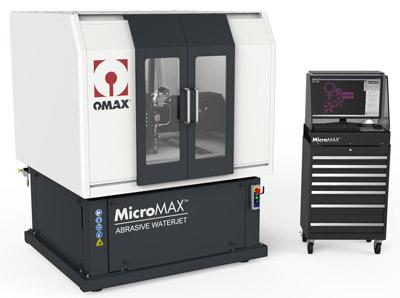
With its MicroMAX JetMachining Center, OMAX reportedly proves the speed, versatility and accuracy of abrasive waterjet technology applies to the cutting ofµm-level parts or part features from a wide range of materials, including exotic metals, advanced composites, polymer thermoplastics and glass.
Ideal for prototype development and production runs, the MicroMAX is a highly rigid machine with a table size of 2 feet 4 inches by 2 feet 4 inches and an X-Y cutting travel of 2 feet by 2 feet. It utilizes advanced high-precision linear encoders, innovative vibration isolation and intuitive software control systems to achieve a position repeatability of less than 3µm and a positioning accuracy of approximately 15µm (0.0006").
The MicroMAX comes equipped with a high precision 7/15 Mini MAXJET5i nozzle that features a 0.007" orifice and 0.015" mixing tube combination for quickly and accurately cutting delicate, complex patterns. Because it forms a jet stream carrying an extremely fine abrasive, the nozzle can produce a kerf as small as 0.015". The machine also has advanced pressure controls for piercing delicate materials.
Now, a smaller version of its OMAX Corp.'s award-winning Tilt-A-Jet cutting head designed specifically for its MicroMAX JetMachining Center is also available. The new Tilt-AJet accessory nearly quadruples the position accuracy of the nozzle enabling the machine to achieve virtually zero taper with most materials up to 3" in thickness. It is also 25 percent smaller and lighter than the Tilt-A-Jet designed for OMAX's other machine models and is nearly twice as rigid for less deflection. The Tilt-A-Jet for the MicroMAX employs 10 degrees of tilt, and is fully sealed for use in the abrasive waterjet environment.
Like all OMAX JetMachining Centers, the MicroMAX is a flexible, cost-effective and beneficial alternative to conventional machining operations. Because waterjet-based machining is a coldcutting process, it eliminates thermal stress in the workpiece, preventing hardening and warping. The MicroMAX also enables manufacturers across all industry segments to accomplish quick turnaround of accurate parts without the hassle of tool changes or complex fixturing, as well as achieve smooth surface finishes without the need for secondary machining.
Contact Details
Related Glossary Terms
- abrasive
abrasive
Substance used for grinding, honing, lapping, superfinishing and polishing. Examples include garnet, emery, corundum, silicon carbide, cubic boron nitride and diamond in various grit sizes.
- abrasive waterjet ( AWJ)
abrasive waterjet ( AWJ)
System that uses high-pressure waterjets in combination with a slurry of fine abrasive grains to machine materials. See waterjet cutting.
- centers
centers
Cone-shaped pins that support a workpiece by one or two ends during machining. The centers fit into holes drilled in the workpiece ends. Centers that turn with the workpiece are called “live” centers; those that do not are called “dead” centers.
- composites
composites
Materials composed of different elements, with one element normally embedded in another, held together by a compatible binder.
- hardening
hardening
Process of increasing the surface hardness of a part. It is accomplished by heating a piece of steel to a temperature within or above its critical range and then cooling (or quenching) it rapidly. In any heat-treatment operation, the rate of heating is important. Heat flows from the exterior to the interior of steel at a definite rate. If the steel is heated too quickly, the outside becomes hotter than the inside and the desired uniform structure cannot be obtained. If a piece is irregular in shape, a slow heating rate is essential to prevent warping and cracking. The heavier the section, the longer the heating time must be to achieve uniform results. Even after the correct temperature has been reached, the piece should be held at the temperature for a sufficient period of time to permit its thickest section to attain a uniform temperature. See workhardening.
- kerf
kerf
Width of cut left after a blade or tool makes a pass.

